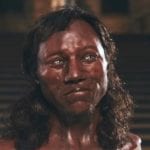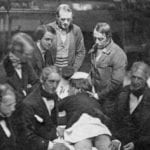10 Bram Stoker Was A Crazy Conspiracy Theorist
While Bram Stoker is best known for writing Dracula, the Irish author penned several other novels that had nothing to do with blood, bats, or the undead. In fact, he even wrote several non-fiction works, including one called Famous Impostors. Published in 1910, the book is dedicated to exposing con artists and hoaxes. At least it does so until the last chapter, when it veers off into crazy land. Titled “The Bisley Boy,” this final chapter claims the Queen Elizabeth we all learned about in history class was actually a man in drag. According to Stoker, the real Elizabeth got sick and died at the age of 10 while vacationing in the countryside. King Henry VIII announced he would pay a visit, and the governess panicked. Instead of facing the head-chopping music, she ran into the nearby town of Bisley to search for a substitute. She couldn’t find a girl who looked like the princess, so the governess grabbed a boy instead and dressed him up in Elizabeth’s clothes. When the king finally showed up, he greeted his supposed daughter and quickly moved along, never noticing anything was wrong. From that point on, Elizabeth was played by this androgynous Bisley Boy, and the whole of England was duped by this heavily made-up impostor. Of course, Stoker is lacking in the proof department. His case rests on some rather dubious assertions, like how Queen Elizabeth had “some secret which she kept religiously guarded.” Stoker’s other evidence includes Elizabeth’s penchant for wigs, which probably hid male-pattern baldness. Plus, she never married, and she refused to see any doctors but her personal physicians. Also, Stoker notes that Elizabeth was incredibly smart. This seemed sure proof that she was secretly a man because Stoker evidently was certain that all women are stupid.
9 Maya Angelou Worked As A Prostitute
A US Poet Laureate and the author of books like I Know Why the Caged Bird Sings, Maya Angelou won numerous awards like the National Medal of Arts and the Presidential Medal of Freedom. She even recited her work at President Bill Clinton’s inauguration. In addition to her writing, Angelou worked as a dancer, a fry cook, a magazine editor, a professor, and an actor. And, oh yeah, she was also a prostitute. Angelou’s life in the sex trade started when she was 17. A single mom working in a San Francisco bar, she became chummy with two lesbian hustlers who frequented the joint. Angelou offered to help out with their rent and stir up some business if they split their proceeds with her. However, her life as a madam was short lived as she caught the two turning tricks without her knowledge and keeping the cash for themselves. Just two years later, Angelou found herself on the other end of the arrangement. She’d met an older, charming man named L.D. “Daddy” Tolbrook, who gave her rides in his fancy car and promised he’d divorce his wife and marry her. Only there was a catch. Tolbrook claimed he owed several thousand dollars to some dangerous gangsters and couldn’t cover his debts. With a con man’s charm, Tolbrook convinced Angelou to work in his brothel and hand over all her earnings so he could pay off the mob. Her brother found out where she was working and convinced her to give up hooking for good. Her life didn’t automatically get easier, though. Shortly afterward, her son was kidnapped, and later, she barely escaped sinking into drug addiction. But despite her hardships, she managed to pull through and eventually recorded this difficult part of her life in her autobiography Gather Together in My Name.
8 Charles Dickens Had A Thing For Dead People
Sure, he wrote some of the most famous novels in the English language, but Charles Dickens was a real weirdo. Wherever he slept, he insisted his bed face northward. The direction of his mattress sparked his creativity. He also followed mesmerism, the Victorian version of hypnotism, often practicing his alleged skills on family and friends. But all these little quirks were nothing compared to Dickens’s dead body fetish. When he wasn’t writing about hungry orphans or grumpy misers, Dickens enjoyed hanging out at the Paris Morgue. Visiting the morgue was the 19th-century version of going to the movies. Bored Parisians with a taste for the macabre would drop by to gawk at the bodies of murder victims, suicides, and folks fished out of the Seine. Dickens’s own fascination with the dead went way past morbid curiosity. As the great author put it, “Whenever I am at Paris, I am dragged by invisible force into the Morgue. I never want to go there, but am always pulled there.” His attraction to corpses was so strong that Dickens ended up at the morgue on Christmas and New Year’s Day, ogling bodies that were shot, stabbed, and swollen. And when he wasn’t in France, Dickens sometimes hung out with the Thames River police, looking for bodies or chatting about suicide attempts with the toll-taker of the Waterloo Bridge.
7 Mark Twain Invented The Bra Strap
In addition to being one of America’s greatest novelists, Mark Twain held a wide variety of jobs like reporter, prospector, and riverboat pilot. He was also an accomplished inventor, taking out at least two patents during his lifetime. In fact, his first invention netted him $50,000, which isn’t bad, especially by 19th-century standards. Mr. Clemens’s creation was a new-and-improved scrapbook. Twain loved collecting pictures and newspaper articles, but he got tired of dabbing glue onto each individual clipping. Wanting to speed up the process, Twain devised a self-pasting scrapbook. The process involved adhesive strips pre-pasted to the pages. All you had to do was moisten the sticky stuff, and presto, you were ready to go. Twain’s most important achievement was a stretchy strap meant to keep loose clothing from falling down. With the help of a handy clasp, the strap prevented “vests, pantaloons, or other garments” from sagging. The device was also detachable, so when changing outfits, you could take it off one pair of undergarments and button it onto the next. Billions of people still use Twain’s invention, only it isn’t detachable, and it isn’t on vests. The man who wrote Tom Sawyer came up with the elastic-clasp strap on the back of the bra.
6 J.M. Barrie Managed The World’s Worst Cricket Team
When he wasn’t writing Peter Pan stories or spending time with kids, J.M. Barrie played cricket. The Scottish author was obsessed with the game and even started his own club. It was possibly the worst team in the history of the game. Founded in 1887, the club was named the “Allahakbarries,” a bad pun based on a mistranslation. Believing “Allahu Akbar” meant “Heaven help us” (it really means “God is great”), the playwright simply glued his name to the end of the phrase and created the team’s title. Barrie also came up with an all-star lineup that included Rudyard Kipling, G.K. Chesterton, A.A. Milne, and P.G. Wodehouse. None of them knew what they were doing. Instead of choosing skilled players, Barrie picked teammates based on whether or not he liked their wives. As for single guys, he chose them only if he thought they looked “interesting.” So it shouldn’t come as a surprise that the Allahakbarries were the worst cricket club in the UK. Before their first game, the clueless players had a serious discussion about which side of the bat they should use to strike the ball. In fact, they were so horrible that Barrie wrote a manual explaining important details, such as “Should you hit the ball, run at once. Do not stop to cheer.” Pretty much the only person with any skill at all was Arthur Conan Doyle, but even he couldn’t save the Allahakbarries from defeat. Barrie chalked up their losses to the well-known fact that great writers are sorry athletes.
5 Philip K. Dick Was Inspired By Visions
Anyone who’s ever read a Philip K. Dick novel knows he had a rather unusual mind. After all, this is the guy who wrote A Scanner Darkly. Even if you’ve never opened a Dick novel, you’ve probably seen a movie or two based on his works. In addition to the aforementioned Scanner, Dick’s novels inspired notable films like Blade Runner, Total Recall, and Minority Report. And in turn, some of his books were inspired by completely crazy visions. On February 20, 1974, Dick was recuperating from wisdom tooth surgery and expecting a delivery of pain meds. When the courier showed up, Dick noticed she was wearing an ichthys necklace. That’s when things got weird. Suddenly, the pendant blasted Dick with a pink laser, filling his mind with an alien presence. This foreign entity shared ancient wisdom with the sci-fi writer, often in ancient languages like Koine Greek. The being, which Dick described as female, also helped him whip his life into shape, encouraging him to eat healthier and crack down on editors running behind schedule. The incident even motivated him to write his VALIS trilogy and an 8,000-page journal called The Exegesis. Dick probably suffered an epileptic seizure, but the author had his own theories. Maybe he was receiving messages from God or extraterrestrials. Or perhaps he was the subject of Soviet experimentation. Or maybe he was the host to the spirit of a dead Greek named Askelpios. While Dick’s ideas sound pretty kooky, one part of the story is hard to dismiss. One day, the entity warned Dick his son would die of a birth defect that doctors hadn’t noticed. Alarmed, the author rushed his kid to the hospital. It turned out the being was right. Baffled doctors were able to save Dick’s son, all thanks to a pink laser beam.
4 Agatha Christie Inadvertently Solved Real Mysteries
Agatha Christie has probably killed more people than any other author on this list—well, fictional people anyway. But while her novels are known for their mysterious murders, one of Christie’s books actually saved lives on three occasions. In her 1961 novel, The Pale Horse, the murderer uses thallium sulfate, a nasty poison that causes difficulty breathing, slurred speech, fainting spells, hair loss, and then death. Of course, the heroic detective catches the crook, and all is well, but The Pale Horse went on to have some serious real-world repercussions. In 1975, a Latin American fan was reading The Pale Horse when she recognized several symptoms of thallium poisoning in her friend. The friend’s husband was slowly murdering her, and the fan alerted authorities in the nick of time. A year later, a London nurse was caring for an extremely sick infant from Qatar. Doctors were unsure what was wrong with the girl, and she was steadily getting worse. But the nurse just so happened to be reading The Pale Horse and started making a few connections. The little girl was losing her hair just like the murder victims in the book. Not only that, but she knew from the book that thallium was a commonly used pesticide in the Middle East. Confident she’d cracked the case, the nurse warned the doctors, and the patient was saved. And perhaps most dramatically, in 1971, people in the town of Bovingdon were dropping left and right with a mysterious illness. However, when a doctor finished reading The Pale Horse, he realized the “Bovingdon bug” was no illness. Thanks to Christie’s expert advice, the doctor realized there was a serial killer on the loose. Police soon arrested the notorious Graham Frederick Young.
3 Arthur Conan Doyle Thought Houdini Was Magical
Even though he created the most logical character in all of literature, Sir Arthur Conan Doyle wasn’t the most rational person on the planet. After his son died in World War I, the author dedicated his life to spiritualism and desperately trying to speak with the dead. This didn’t sit well with his friend Harry Houdini. A renowned skeptic, Houdini regularly sneaked into seances to expose fraudulent psychics. But despite their differences, the two men got along pretty well. Many of their conversations revolved around spiritualism, with each trying to prove his point to the other. Doyle often took Houdini to his favorite mediums, while the magician tried to convince the author his religion was a sham. Things got weird, though, when Doyle proclaimed that Houdini actually had magic powers. The writer thought Houdini was disproving rival mystics so everyone would marvel at his own psychic powers. He even claimed the magician could dematerialize, and that’s how he escaped from all those chains, straitjackets, and safes. Frustrated, Houdini cooked up a trick to prove to his friend that magic wasn’t real. Houdini’s act involved a slate, cork balls, and a bucket of white paint. Doyle was instructed to drop a ball into the bucket and then was asked to leave the house. Armed with pencil and paper, Doyle walked three blocks away, wrote down a secret message, and returned. The author then took the paint-covered ball out of the can, dropped it on the slate, and watch in wonderment as the ball rolled along, spelling out “Mene Mene Tekel Upharsin,” the exact phrase he’d secretly written down. The ball was filled with iron and controlled by a magnet. And how had Houdini known what Doyle had written? He simply asked for the paper, checked to see if it was still folded, palmed it, and replaced it with a blank slip. At the end of the act, the magician asked Doyle to return the empty paper, preventing him from learning the secret—which was a big mistake. “I won’t tell you how it’s done,” Houdini said, “but I can assure you it was pure trickery.” The man’s plan backfired completely—Doyle was now totally convinced his friend had psychic abilities. Houdini never did persuade his friend to give up spiritualism. His war on clairvoyant con artists caused the men to part ways. Sadly, they never patched things up and spent the rest of their lives feuding.
2 Stieg Larsson Trained Guerrillas
We all know Ernest Hemingway was a genuine action hero. He served in World War I as an ambulance driver, started his own militia in World War II, and even hunted U-boats off the coast of Cuba. But Papa wasn’t the only macho dude in the world of literature. Stieg Larsson, the Swedish author of the Millennium series, was also quite the adventurer. As a young man, he backpacked his way across Africa, and later as a left-wing journalist, he lived under threat of death from neo-Nazis. Larsson’s biggest claim to awesomeness came in 1977, when he went to Ethiopia and trained female guerrillas. These women were members of the Eritrean People’s Liberation Front, a Marxist organization fighting for Eritrean independence from Ethiopia. Not only were they up against the Ethiopian Army, but they were battling Soviet advisers and Cuban troops as well. Fortunately, the rebels had Stieg Larsson on their side. This ex-soldier spent a year training the squad how to fire grenades at enemy troops, but he later had to go home after developing an inflamed kidney. While Larsson died before The Girl with the Dragon Tattoo became an international bestseller, he did live long enough to see Eritrea gain its independence.
1 Norman Mailer Stabbed His Wife And Fought Rip Torn
Norman Mailer was a jerk, plain and simple. He might’ve snagged Pulitzers for The Executioner’s Song and The Armies of the Night, but he’s also the most unpleasant person on this list. A raging alcoholic, Mailer was known for his violent behavior which included throwing down with actor Rip Torn. It was the late ’60s, and Mailer was directing a film called Maidstone. Torn was playing the protagonist, only things were most tense behind the scenes. Mailer was changing the screenplay, and that didn’t sit well with Rip, who was supposedly on acid at the time. When cameras started rolling, Torn grabbed a hammer and seriously whacked Mailer in the head. The two went to the ground, wrestling and rolling around. As their family members screamed off-camera, Mailer bit Torn’s ear, and the actor returned the favor by choking Norman with his bare hands. Sure, you can say he was acting in self-defense, only this shocking behavior was par for the course with Mailer. He once punched author Gore Vidal in the face and later helped murderer-author Jack Abbott get out of prison. Abbott killed again, but Mailer didn’t care, claiming “culture is worth a little risk.” And then there’s the time he nearly stabbed his second wife to death. It was 1960, a particularly weird year for Norman Mailer. He was running for mayor of New York City, claiming he’d outlaw private cars, institute trial by jousting, and turn the Big Apple into the 51st state. He also wouldn’t shut up about “macho existentialism,” his personal philosophy, which involved violence and a fascination with knives. His psychopathic tendencies boiled over during a campaign party in his apartment. After spending the evening fighting guests and random people in the street, his wife, Adele Morales, slung a few choice words his way. Enraged, Mailer pulled out his penknife and stabbed Morales twice, once in the back and once in her abdomen. When the police arrived, Morales claimed she’d fallen on glass. She later admitted what had happened, but the writer got off. During his trial, Mailer insisted on his sanity, calling the stabbing some sort of artistic experiment. Thanks to Morales asking for leniency and a smarmy lawyer claiming his new book would benefit society, Mailer’s sentence was suspended. He went on to write many a book and punch many a face. If you want to keep up to date on Nolan’s writing, you can friend/follow him on Facebook. You can also send him an email here.
























